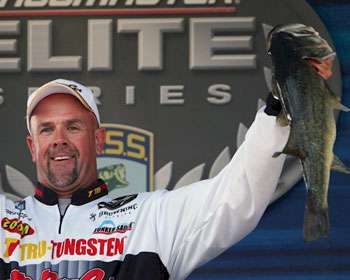
Talk to any diehard crankbait fisherman and you'll likely hear terms like digging, deflecting, and bumping. In most cases, crankbait bites are generated from contact with something under the surface from grass to rock to wood. However, Elite Series pro Marty Stone is quick to point out that there are times when fishing a crankbait in open water can be really productive.
"Most of the time when you're cranking in open water where the bait doesn't contact anything, you're looking for a reflex or a sight bite," explains Stone. For that reason, the North Carolina pro restricts open water cranking to clear water reservoirs with at least 2 feet of visibility. There is a difference between letting the bass see the bait and letting them get a good look at the offering. "You don't want the bass to get a good look at the crankbait because if it does, you don't have a chance," he explains. "If you keep it smoking all the way back to the boat, you're going to generate a reaction bite. The faster you can reel it, the faster the fish will react."
In clear water, a fast retrieve also has the capability to draw bass from great distances, a quality that can be lethal. "The farther you can bring the fish in clear water, the better your chances of hooking up," says Stone. "If the bass has to travel 15 feet to hit the lure, by the time it gets there it's committed. That fast moving crankbait makes the bass so angry that you can actually see the red in their eyes after you land them."
Stone's tackle for open water cranking includes a 6:1 gear ratio Ardent baitcast reel paired with an American Rodsmith Signature Series 7-foot rod. Unless he's throwing a lipless crankbait, he opts for 12- to 15-pound-test monofilament. With a lipless crankbait, Stone uses braided line. When fishing crankbaits in open water, Stone keys on three main things. Milfoil, windy banks, and open water schools of smallmouth, depending on where he's fishing. When fishing emerging milfoil, Stone likes to burn a crankbait over the grass. "I'm not talking about burning it through the grass, I'm talking about burning it over the top of the grass," he stresses. The fast retrieve draws bass out of the grass and triggers a reflex strike. Stone believes a slight chop on the surface also increases the number of bites when burning a crankbait over the grass.
During fall, windy banks and points offer another target for Stone to burn a crankbait. "After the lake turns over in the fall, usually around October or November, I'll get on windy banks and points and throw a lipless crankbait like the Lucky Craft LV 500," explains Stone. Using braided line, he launches the offering as far as possible and then retrieves it as fast as he can turn the reel handle. Stone has seen bass come from 20 feet of water to crush a diving bait.
When fishing northern waters, Stone likes to burn a deep diving crankbait over schools of smallmouth. It's a technique he says can fool the biggest smallmouth in the school. "The school will be sitting in 25 feet of water, and I'll burn a crankbait over the top of them in about 12 feet," he explains. "Those smallmouth will come a long way to hit a bait. You don't catch a lot of bass doing that but you can catch some absolute brutes." So is there ever a time when Stone will fish a crankbait in open water with a slow retrieve? "If I have to slow down, that's not a crankbait bite, that's a jerkbait bite," he says. "In fall, most of the time your dealing with speed. Speed triggers because the bass are really feeding."




